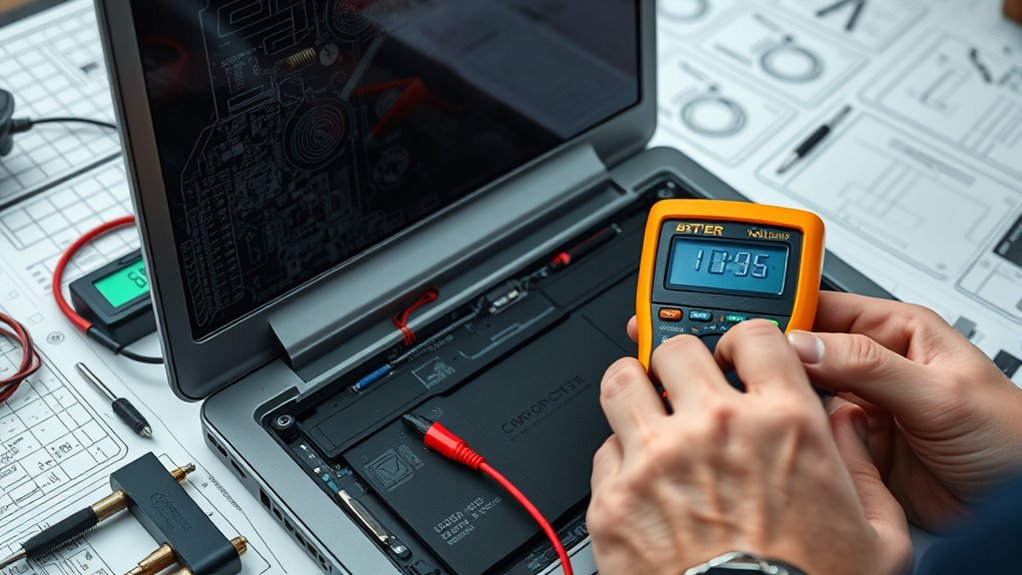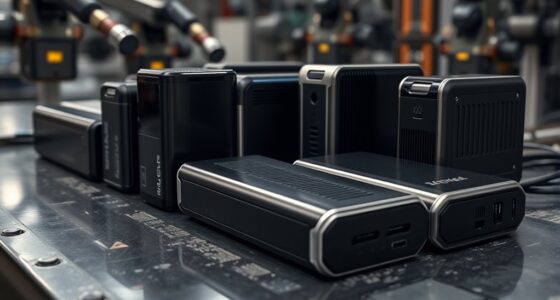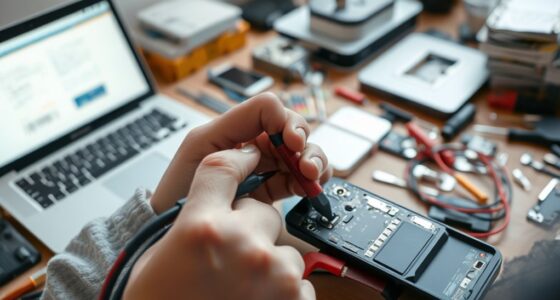First, plug your device into a known working outlet and check your charging cables and adapters for damage. Clean out the charging port from dust or debris and try a different cable or charger if possible. Restart or reset your device, and make sure your software is up-to-date. If issues persist, inspect the battery and consider professional repair. Continuing this process will guide you through more detailed steps to fix your charging problem.
Key Takeaways
- Verify the power source, cables, and adapters are functioning correctly and securely connected.
- Inspect the device’s charging port for debris, damage, or corrosion and clean if needed.
- Restart the device and reseat removable batteries carefully to resolve minor glitches.
- Check battery health and usage habits to identify signs of degradation or improper usage.
- Update device software and firmware regularly; seek professional repair if issues persist.
Checking the Power Source and Connections

Before troubleshooting your battery charging issues, you should first verify that the power source and connections are working properly. A stable power outlet and secure connections are essential for proper charging. If your device isn’t charging, check if the outlet works by plugging in another device. Loose or damaged cables can disrupt the charging process, so ensure your cables are intact and properly connected. Poor charging habits, like frequently letting your battery drain completely or overcharging, can reduce your battery lifespan. Using the right charger and avoiding extreme temperatures also help maintain battery health. Ensuring your power source and connections are reliable is a crucial step in preventing damage to your device’s battery. By confirming your power source and connections are solid, you eliminate simple issues that could be causing charging problems and set the stage for further troubleshooting.
Inspecting the Charging Cable and Adapter
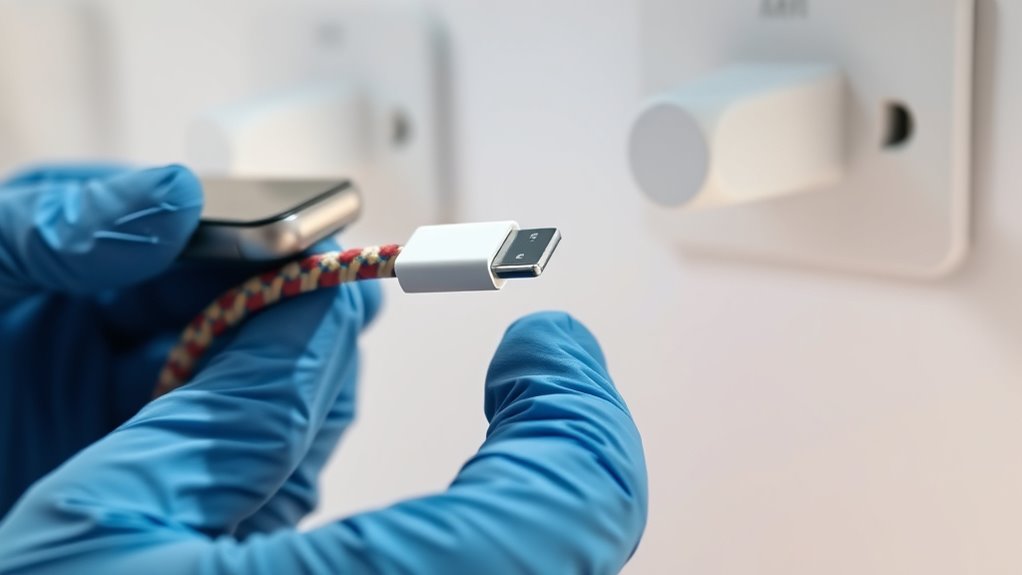
Often, charging issues stem from problems with the cable or adapter rather than the device itself. Check for visible damage like frayed wires or bent connectors. Test the cable and adapter with another device to confirm they’re working properly. If the cable shows wear or doesn’t fit securely, consider cable replacement. Also, make certain your adapter is compatible with your device; using an incompatible one can cause charging problems. Here’s a quick comparison:
| Aspect | What to Check |
|---|---|
| Cable condition | Look for frays, kinks, or damage |
| Adapter compatibility | Verify voltage and connector type |
| Proper fit | Ensure secure connection |
Addressing these points can often resolve charging issues without further troubleshooting.
Additionally, compatibility considerations are crucial to ensure your charging setup functions properly.
Examining the Device’s Charging Port
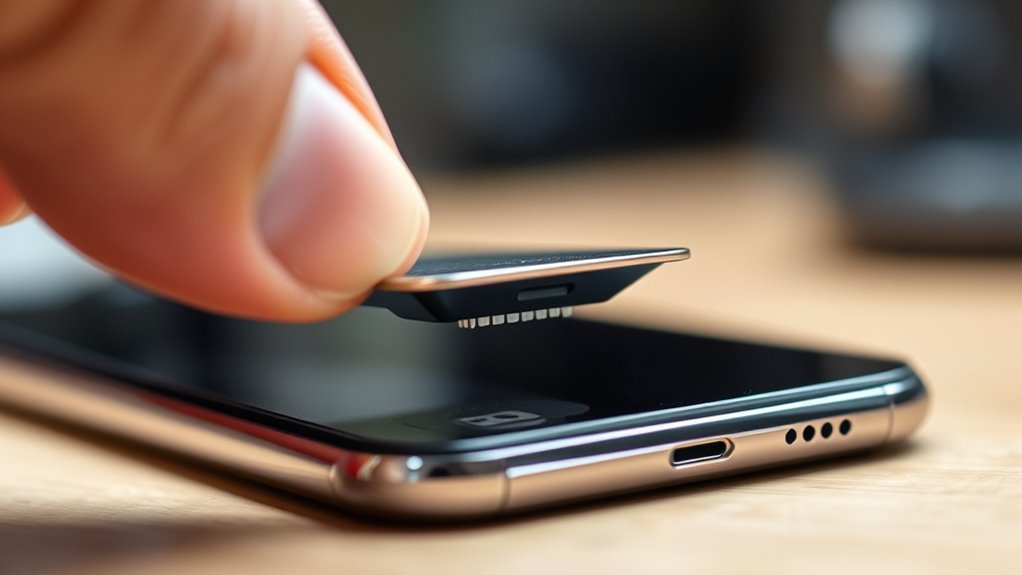
Start by checking the charging port for any debris, dust, or lint that could block the connection. Look for visible signs of damage or bent pins that might prevent proper charging. Finally, test the port connection by gently plugging in your cable to see if it fits snugly and stays secure. Inspecting the port for damage can help identify issues that may require professional repair or replacement.
Check for Debris
Debris in the charging port can prevent your device from charging properly, so it’s important to examine it carefully. Dust accumulation, lint, or foreign objects like small pieces of paper can block the connection between the charger and the device. Turn off your device and use a flashlight to inspect the port closely. If you see dust or debris, gently remove it with a soft brush, a toothpick, or compressed air—be careful not to damage the pins inside. Avoid using metal objects that could cause a short circuit. Clearing out any foreign objects or dust guarantees a secure connection, which can improve charging performance. Regularly checking and cleaning the port can help prevent charging issues caused by debris buildup. Additionally, understanding device maintenance practices can prolong your device’s lifespan and ensure optimal performance.
Inspect for Damage
Inspecting for damage is a crucial step when troubleshooting charging problems, as physical harm to the port can prevent your device from charging properly. Look closely at the charging port for signs of physical damage, such as bent or broken pins, cracks, or loose connections. Battery corrosion, often caused by moisture, can also interfere with proper charging; check for any white, green, or bluish buildup inside the port. Corrosion can block electrical contact, leading to charging issues. If you notice any physical damage or corrosion, avoid inserting the charger until the problem is addressed. Damaged ports can sometimes be repaired, but often require professional replacement to restore proper function. Ensuring the port is free from damage is essential for reliable charging performance. Additionally, HEPA filtration in some devices can help maintain the overall health of internal components by reducing dust and allergens that may contribute to hardware issues.
Test Port Connection
After checking for physical damage or corrosion, the next step is to test the connection between your device and the charger. Port testing involves inspecting the charging port for debris, dust, or bent pins that could disrupt connection stability. Gently clean the port with a soft brush or compressed air if needed. Then, plug in your charger securely, ensuring it fits snugly without wobbling. If the connection feels loose or unstable, try a different cable or charger to determine if the issue lies with the port or the power source. Consistent, stable connection is essential for proper charging. By verifying port integrity and connection stability, you’ll identify whether the port is functioning correctly or needs professional repair. Additionally, testing the port’s electrical contact can help determine if internal components are functioning properly.
Monitoring Battery Health and Usage Patterns
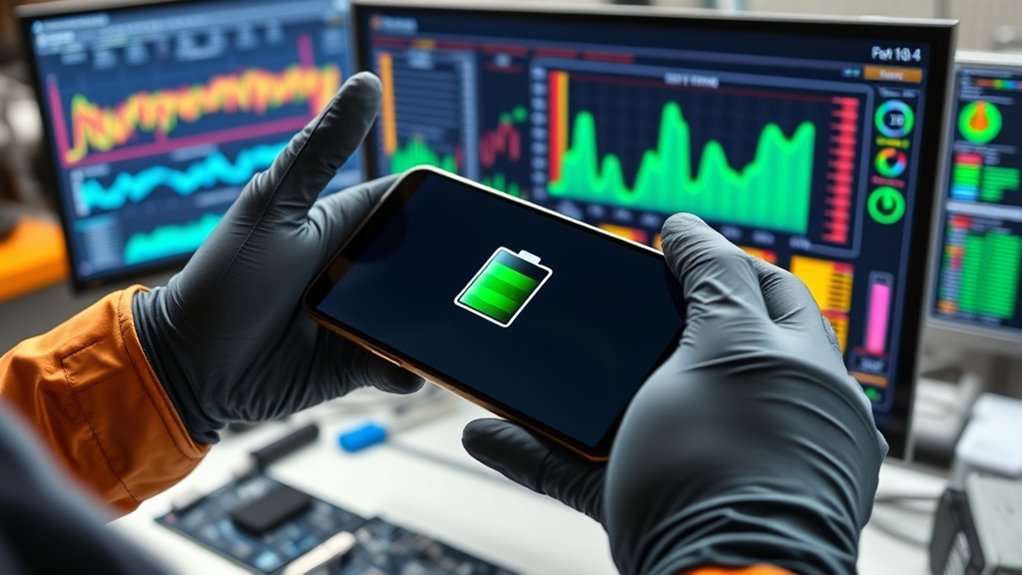
Monitoring your battery’s health and usage patterns is essential for diagnosing charging issues and extending its lifespan. Regularly check your battery capacity to identify declines that may signal degradation. Pay attention to usage trends, such as frequent full discharges or constant high screen brightness, which can accelerate battery wear. If you notice the battery drains quickly or charges slowly, these signs may indicate underlying problems. Tracking how often and in what ways you use your device helps you spot irregularities and adopt better habits. Using built-in tools or third-party apps, you can gather data on charge cycles and performance over time. Staying aware of these factors enables you to address potential issues early and optimize your battery’s longevity. Additionally, understanding how creative practice can foster resilience helps in developing adaptive strategies for managing battery health.
Resetting or Rebooting the Device
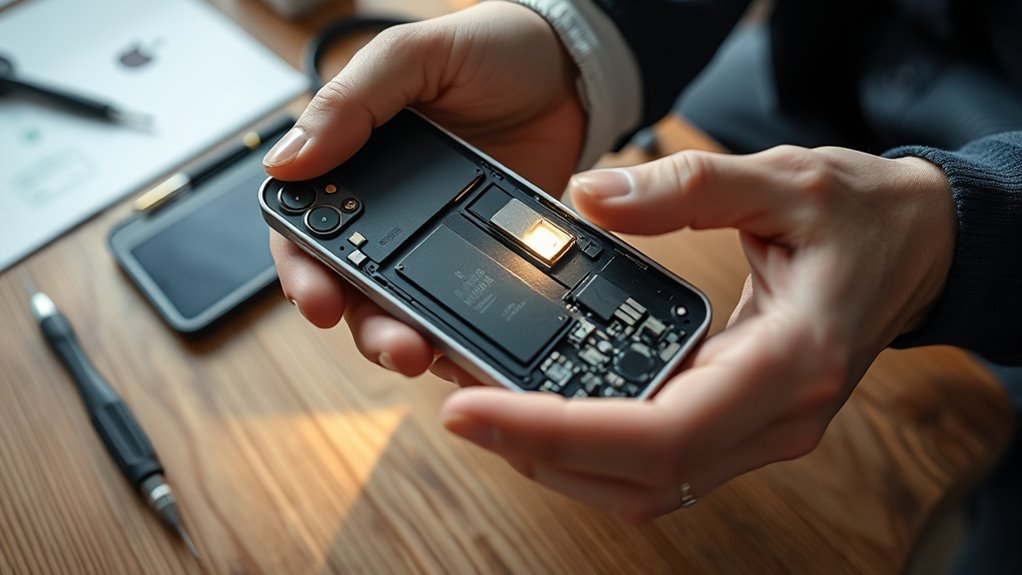
To fix charging issues, start by power cycling your device; turn it off, wait a few seconds, then turn it back on. If your device has a removable battery, safely take it out, wait a moment, and reinsert it before turning the device on again. These simple steps can often resolve minor glitches that affect charging. Additionally, ensuring that your device’s power management system is functioning correctly can help prevent recurring issues.
Power Cycle Device
Sometimes, simply power cycling your device can resolve charging issues. This resets the system and can refresh the battery capacity, helping the charging indicators display correctly. To do it:
- Turn off your device completely.
- Unplug it from the charger and wait 30 seconds.
- Turn the device back on and reconnect the charger.
- Using an online tool to detect passive voice can help you review your writing for clarity and style.
This process can clear minor glitches that prevent proper charging or cause false battery readings. Power cycling resets the device’s hardware and software, often restoring accurate charging indicators and improving battery performance. If your device still shows inconsistent charging or battery capacity issues after a restart, further troubleshooting may be needed. But in most cases, a simple power cycle is enough to fix temporary problems.
Remove Battery Safely
If power cycling your device doesn’t resolve charging problems, removing and reseating the battery can help reset the system. First, confirm you follow safety precautions to avoid damage or injury. Turn off your device completely and disconnect it from any power source. Carefully locate the battery compartment, and if needed, use appropriate tools to open it. During battery removal, handle the battery gently, avoiding punctures or bending. Keep in mind that some devices have built-in batteries that require specific procedures; consult your user manual if unsure. Once the battery is removed, wait for a minute before reseating it securely. Reassemble your device, reconnect power, and turn it on. This process can clear minor glitches and improve charging performance. Additionally, inspecting for battery damage can prevent further issues.
Updating Software and Firmware
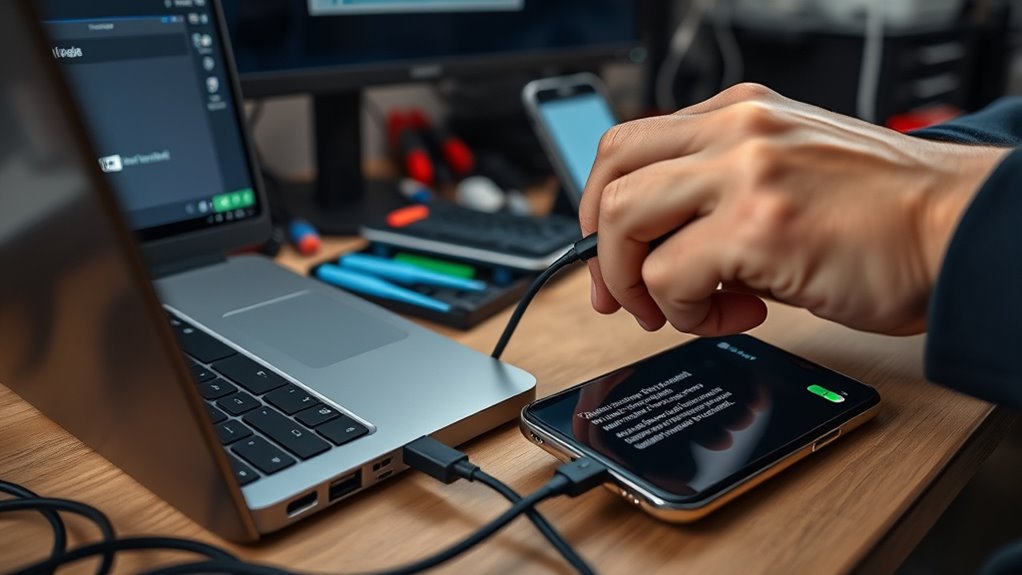
Updating your device’s software and firmware is a crucial step in resolving battery charging issues, as outdated versions can cause compatibility problems and bugs. When you perform regular software updates and firmware upgrades, you guarantee your device runs smoothly and efficiently. Here’s what you should do:
Regularly updating your device’s software and firmware ensures optimal performance and prevents charging issues.
- Check for available updates through your device’s settings or manufacturer’s app.
- Download and install the latest software updates to fix bugs and improve performance.
- Follow prompts carefully during firmware upgrades to avoid corrupting your device.
Updating keeps your system compatible with new accessories and charging protocols, reducing charging problems. Remember, outdated firmware can lead to miscommunication between hardware components, causing battery issues. Staying current with software updates and firmware upgrades helps maintain battery health and overall device performance. Additionally, software updates often include security patches that protect against vulnerabilities affecting device operation.
When to Seek Professional Repair Services

When you notice persistent or severe charging problems that don’t resolve after troubleshooting, it’s time to contemplate professional repair services. You should seek expert help when basic fixes, like checking cables or updating software, don’t improve the situation. A professional diagnostics assessment can identify underlying issues that aren’t visible or easily fixable on your own. If your device continues to have charging problems despite your efforts, a repair service can pinpoint hardware faults or internal damage. Ignoring these signs might lead to further damage or complete failure. Trusting a professional ensures the problem gets addressed safely and effectively, saving you time and preventing potential safety risks. Ultimately, when troubleshooting no longer works, seeking expert repair services is your best move.
Frequently Asked Questions
Can Extreme Temperatures Affect Battery Charging Performance?
Extreme temperatures markedly impact your battery’s charging efficiency. When it’s too hot or cold, the temperature impact can cause your battery to charge slower or not at all. High heat may damage internal components, while cold temperatures reduce chemical reactions needed for charging. To optimize your battery’s performance, keep it within recommended temperature ranges, especially during charging, and avoid exposing it to extreme conditions.
How Do I Calibrate My Battery for Accurate Charge Readings?
Ever wonder if your battery’s telling the truth? To verify charge level accuracy, you need to perform battery calibration. Fully charge your device, then let it drain completely until it shuts off. Recharge it to 100% without interruption. Repeat this process once or twice. This resets the battery’s sensor, helping it report more accurate charge levels and extending its lifespan. Proper calibration keeps you in control, knowing exactly how much power remains.
Is It Normal for Charging Speed to Vary Throughout the Day?
You might notice charging speed fluctuations during the day due to daily voltage variation, which is normal. External factors like temperature changes, power source stability, and device activity can also influence how quickly your device charges. These variations are common and usually don’t indicate a problem. If you experience consistent slow charging or irregular patterns, it’s worth checking your charger and cable, but occasional fluctuations are just part of natural daily voltage variation.
What Safety Precautions Should I Take During Battery Troubleshooting?
Imagine standing near a sparking circuit, sparks flying as you handle electrical safety. During battery troubleshooting, always handle electrical safety with care—wear insulated gloves and avoid contact with terminals. Use proper tools for battery inspection tips, like a multimeter, and guarantee the area is dry and well-ventilated. Keep away from flames or heat sources, and disconnect power before inspecting or servicing to prevent shocks or fires.
Do Third-Party Chargers Impact Device Battery Health?
Using third-party chargers can impact your device battery health if the charger quality is poor or if it’s not compatible with your device. Always check device compatibility before using a third-party charger, and opt for reputable brands to guarantee safety and reliable charging. Poor quality chargers may deliver inconsistent power, which can degrade your battery over time, so prioritize high-quality, compatible chargers to protect your device’s longevity.
Conclusion
When your device’s battery refuses to cooperate, think of it as a stubborn garden plant that needs a little extra care. By troubleshooting step-by-step, you’re nurturing its health back to life. Sometimes, the issue’s just a small pebble in the shoe, and other times, it’s a sign to seek expert help. Trust your instincts, stay patient, and soon your device will be humming along like a well-tuned symphony once again.
